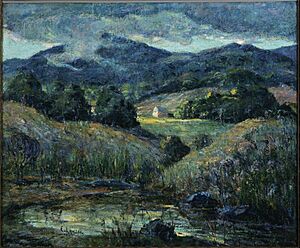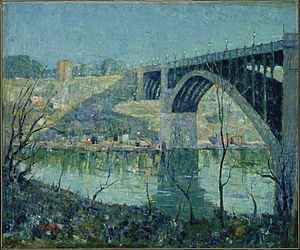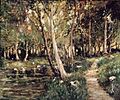Ernest Lawson facts for kids
Quick facts for kids
Ernest Lawson
|
|
|---|---|
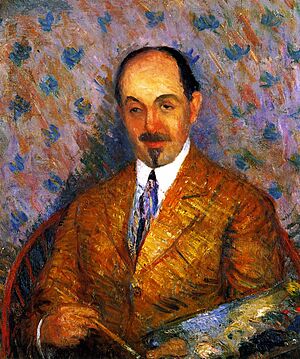
Portrait by William Glackens, 1910
|
|
| Born |
Ernest Lawson
March 22, 1873 Halifax, Nova Scotia, Canada
|
| Died | December 18, 1939 (aged 66) Miami, Florida, US
|
| Nationality | Canadian, American |
| Education | Kansas City Art Institute (1888); Art Students League, New York (1891), where he was taught by John Twachtman and J. Alden Weir, whose summer school he attended at Cos Cob, Connecticut; Académie Julian, Paris (1893) with Jean-Paul Laurens |
| Known for | painter |
| Spouse(s) | Ella Holman |
| Awards | Universal Exposition in St. Louis in 1904 (silver medal); Corcoran Art Prize, Washington, DC (1916) |
| Elected | Canadian Art Club (1912); National Academy of Design (full member, (1917); National Institute of Arts and Letters |
Ernest Lawson (born March 22, 1873 – died December 18, 1939) was a talented Canadian-American painter. He showed his art with the Canadian Art Club. He was also part of an American art group called The Eight. This group formed in 1908. They wanted to show different kinds of art. They felt that the main art academy was too strict.
Lawson mostly painted landscapes, which are scenes of nature. He also painted some city scenes. His painting style was inspired by artists like John Henry Twachtman, J. Alden Weir, and Alfred Sisley. People often call him a Canadian-American Impressionist. His art style is a mix between Impressionism and realism.
Contents
Early Life and Art Training
Ernest Lawson was born in 1873 in Halifax, Nova Scotia, Canada. His family was well-known. In 1888, he moved to the United States and lived in Kansas City.
In 1891, he moved to New York City. He took classes at the Art Students League. There, he studied with John Twachtman. Twachtman taught him about Impressionism, which was a big influence on Lawson. He continued to study with Twachtman and J. Alden Weir at their summer art school in Connecticut.
In 1893, Lawson traveled to France. He studied at the Académie Julian in Paris. He also practiced plein air painting, which means painting outdoors. He met the English Impressionist Alfred Sisley in France. In 1894, Lawson showed two of his paintings in the famous Paris Salon exhibition. Later, he married Ella Holman, who used to be his art teacher.
Developing His Own Style
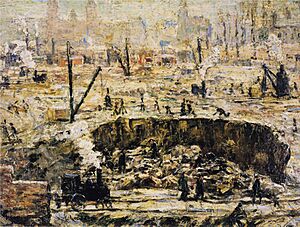
Lawson returned to the United States in 1896. He began to create his own unique art style. Other artists like Robert Henri and William Glackens encouraged him. He started spending time with them around 1903.
In 1898, Lawson moved to Washington Heights, Manhattan in New York City. For the next twenty years, he painted scenes from this area. He painted parks, rivers, bridges, and hills. These places were still wild and natural back then. His paintings often showed quiet, empty landscapes. But they were full of rich colors and textures. One art critic called his colors a "palette of crushed jewels."
Like other realist painters, Lawson painted outdoors. He also traveled to find new and interesting places to paint. He visited Spain, New Hampshire, Florida, and many other states. He had his first solo art show in 1907. He won a prize for a winter landscape painting. Winter scenes became one of his most famous subjects.
In 1908, he joined "The Eight." This group included famous artists like Robert Henri, William Glackens, and John Sloan.
The Eight Art Group
Ernest Lawson was a quiet and polite person. He was not the kind of artist you would expect to be a rebel. He didn't like to promote himself. He also didn't paint the rougher parts of city life, which many artists in "The Eight" did.
However, Lawson agreed with Robert Henri and others. They felt that the art shows in New York were too closed off. They thought it was like a "private club" where only certain art was allowed. They wanted to change this system.
The exhibition by "The Eight" at the Macbeth Galleries in New York in 1908 caused a stir. It was a big success, even if sales weren't huge. The artists became famous in the news. People with traditional tastes were shocked. But many young artists came to see the new, modern art. The show later traveled to Chicago and Boston. It helped start a big discussion about what American art should be like. Lawson and his friends helped bring new styles and subjects to American art.
Even though he was part of this "rebel" group, Lawson was also accepted by the art world. He became an associate member of the National Academy of Design later that year. He became a full member in 1917. He also showed his art with the Canadian Art Club. He won many awards throughout his career. Other artists respected him greatly. William Merritt Chase even called him America's greatest landscape painter.
But even with all this praise, Lawson often had money problems. He also had poor health in his later years.
Lawson was asked to show three paintings at the important Armory Show in 1913. This show brought many new European art styles to America. Lawson was open to new ideas, especially Post-Impressionism. He learned that Impressionism sometimes focused too much on light and not enough on solid shapes. In his later works, he tried to make his paintings feel more solid and real.
Later Years
In the 1910s and 1920s, important art collectors bought Lawson's work. But his art became less well-known as new art movements appeared.
Eventually, Lawson left New York. He visited Florida often, staying with his friends and supporters, Katherine and Royce Powell. He moved to Florida permanently in 1936. In his last years, he painted a mural for a post office (which is no longer there). He mostly focused on painting the beautiful Florida landscape.
Sadly, Ernest Lawson passed away unexpectedly in 1939. He was swimming at Miami Beach.
Today, Lawson's work is not as famous as some of his friends' art. But his best paintings are in many art museums across North America. Robert Henri, another artist, said Lawson was "the biggest [landscape artist] we have had since Winslow Homer."
Lawson's paintings also show us what parts of Manhattan looked like long ago. For example, his 1903 painting of the Cathedral of Saint John the Divine shows it being built in a wooded area. Today, that area is a busy city neighborhood. Lawson's art helps us remember a world that has completely changed.
Images for kids


